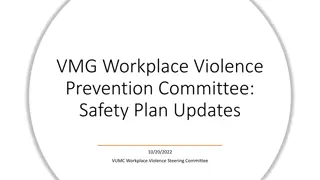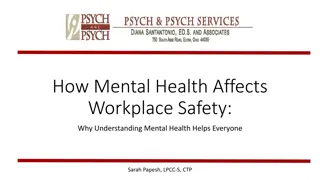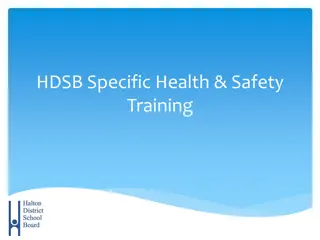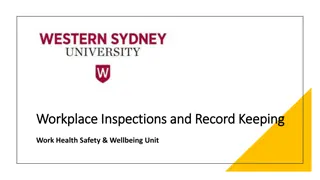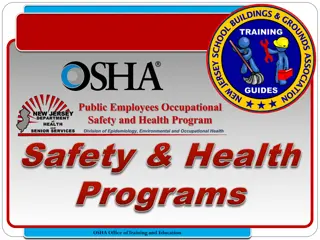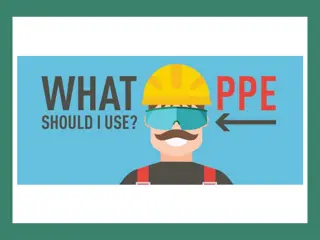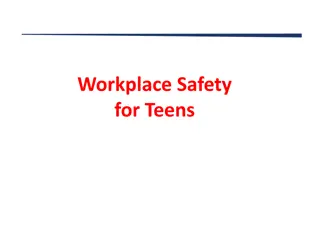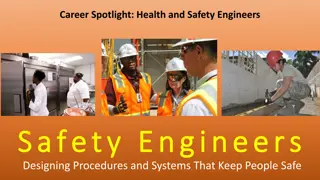Workplace Safety Training Overview
Explore workplace safety training content covering topics like workplace assessment, violence education, accountability, W.A.V.E. approach zones, signs of aggression, and 6 steps to safety. Learn about appropriate approaches to individuals, risk identification, self-protection techniques, and accountability in various workplace scenarios.
Download Presentation

Please find below an Image/Link to download the presentation.
The content on the website is provided AS IS for your information and personal use only. It may not be sold, licensed, or shared on other websites without obtaining consent from the author.If you encounter any issues during the download, it is possible that the publisher has removed the file from their server.
You are allowed to download the files provided on this website for personal or commercial use, subject to the condition that they are used lawfully. All files are the property of their respective owners.
The content on the website is provided AS IS for your information and personal use only. It may not be sold, licensed, or shared on other websites without obtaining consent from the author.
E N D
Presentation Transcript
Welcome and Introductions Your name and workplace. Housekeeping: Length of session Phones Washrooms Emergency exits
What does W.A.V.E. stand for? W orkplace A ssessment V iolence E ducation
What you will learn The appropriate approach to an individual (e.g., client). An awareness of yourself, your environment and an individual. The basic principles to identify risks and then eliminate or manage the risk(s). The basics of how to protect yourself in an adverse situation, keeping respect and professionalism foremost. (in WAVE 303 only) A few techniques to break away from a pinch, hold or choke.
Accountability We are all accountable, you, your manager/supervisor, VP s right up to the CEO. Generally: To give an explanation for your conduct. Being responsible and answerable. Day to Day, for: Following policy. Using the skills you received in training. The decision/action you make. Performing your duties accurately and appropriately Asking for help/assistance or additional training
WAVE Approach Zones Green Green it s okay it s okay Yellow Yellow- - Caution Caution Red Red Stay Stay away away
Approach Zones Green Green it s okay it s okay Yellow Yellow- - Caution Caution Red Red Stay away Stay away
Activity Too close for comfort?!?!
Signs of Aggression
6 Steps to Safety 1. Make eye contact, if appropriate. 2. Choose the appropriate yellow zone. 3. Determine a safe distance and stay there. 4. Turn your body to minimize target areas. 5. Talk with your hands keep them visible. 6. Assess the individual.
Whats Your Line **Clear communication is very important. State clearly who you are, why you are there and what you will be doing.**
Make eye contact with the individual (if appropriate) Things to look for: Mood. Health. Possible intentions. Which light are they displaying.
Choose the appropriate yellow zone Questions to ask yourself: Which is my dominant side right or left? Which appears to be their dominant side right or left? Approach with your dominant side to their non-dominant side.
Determine a safe distance Consider these factors before moving closer: Individual s size and level of mobility Environmental space Objects that could be used as weapons (e.g., cane, walker, hot beverage, pen)
Turn your body at an angle Turning slightly sideways reduces target areas and helps to make you less threatening Puts your dominant side forward so you are more prepared to respond
Talk with or show your hands Simply approaching with open body language can convey a non-threatening attitude. People may be suspicious of you if they can t see your hands. Your hands will be in a position to respond.
Assess the Client Ask open-ended questions, paying attention to their response. Listening to what they re saying and how they say it.
Practice 6 Steps to Safety What s my line 1. Making eye contact 2. Choose the appropriate yellow zone 3. Determine a safe distance 4. Turn your body at an angle 5. Talk with or show your hands 6. Assess the client
Approaching Closer 1.Lower Approach 2.Gaining Control 3.Redirecting Technique 4.Leaving the Area
Approaching Closer Standing over someone may be perceived as a domineering stance Lower Approach Go lower and into a 3-point stance if you can. Puts you on both feet and one knee, not just on the balls of your feet. Caution this could make you an easier target.
Approaching Closer Gaining Control Reaching out to tap someone s arm, perhaps by the wrist, can help you continue to assess to client. Are their muscles tensing up? Is their arm getting ready to move (yellow light moving toward red)? Are they relaxed and open to you talking to and touching them. (yellow to green)
Approaching Closer Redirecting Technique As you are in the lower approach and the client may attempt to strike out, try to use their force to redirect the blow or to give yourself momentum to move away from the client.
Approaching Closer Leaving the Area Once you ve established that the client and others in the area are safe, leave the area. Keep yourself safe, even if it means leaving.
Activity Approaching Closer
The 3 Ps of a Right Attitude Positive Professional Productive
5 Safety Scans for Community Workers 1. While driving to the location 2. Before exiting your vehicle 3. Exiting your vehicle and before closing the door 4. Walking in to meet the client 5. While meeting and assessing the client
Other Contributors to Violence 1. Times of distress Hearing bad news, being in a waiting room, not understanding what s happening 2. Medical conditions Dementia, pain, others 3. Substance abuse Drugs and/or alcohol 4. Environment Busy, strange place
To Protect Yourself, You Can Secure your personal property. Locker, car, purse, wallet, etc. Always be aware of your surroundings. Trust your instincts. Be aware of your own complacency. Plan for events before they happen.
To Protect Yourself, You Can Be aware of suspicious activity. If working alone, have ways to communicate with others. Have respect for others and their situation. Have a proper attitude at work 3 Ps Positive Professional Productive
Bringing it all together Approach be aware of the Green, Yellow and Red Zones Communication be clear Document, report incidents know the process in your work area
WAVE Breakaway Techniques
Safe Practice DURING PRACTICE, IF AT ANY TIME YOU ARE EXPERIENCING PAIN OR DISCOMFORT, STOP and TELL YOUR TRAINER or PRACTICE BUDDY TO STOP!! Practice using slow deliberate moves
Key points 1. Communicate, calmly and assertively. 2. Maintain your self control. 3. Only match your level of response to the level of assault.
WAVE Breakaway Techniques Arm Grab (3 techniques) Pinch Release (2 techniques) Hair Pull (front and back) Choke Release (front and back) Covering Up technique
Bringing it all Together Approach be aware of the Green, Yellow and Red Zones Communication clear Use an appropriate breakaway technique to match the level of assault Document, report incidents









